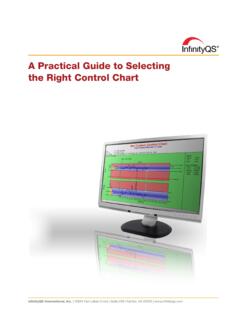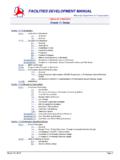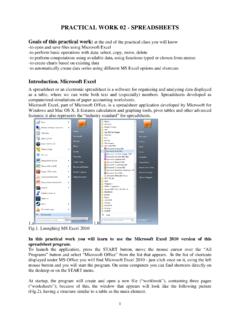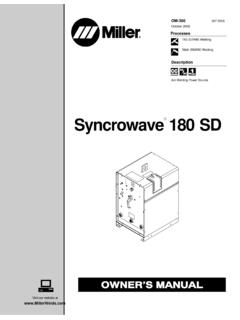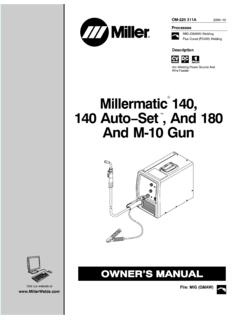Transcription of Guide to Air Cleaners in the Home - epa.gov
1 2 Guide to Air Cleaners in the HomePortable Air Cleaners and Furnace or HVAC Filters in the HomeIndoor air contains pollutants that can affect human health. Some of these pollutants come from outdoors, and others come from indoor sources and activities, such as cooking, cleaning, secondhand smoke, building materials, consumer products, and home furnishings. These indoor air pollutants can be particles or gases, including volatile organic compounds (VOCs). Common contaminants that can be found indoors include particulate matter (including [fine] and PM10 [coarse]), formaldehyde, mold, and pollen. Indoor air quality will vary from home to home and over the course of a day within a home. Since most people spend about 90% of their time indoors, mostly in their homes, much of their exposures to airborne pollutants will happen in the most effective ways to improve your indoor air are to reduce or remove the sources of pollutants and to ventilate with clean outdoor air.
2 In addition, research shows that filtration can be an effective supplement to source control and ventilation. Using a portable air cleaner and/or upgrading the air filter in your furnace or central heating, ventilation, and air-conditioning (HVAC) system can help to improve indoor air quality. Portable air Cleaners , also known as air purifiers or air sanitizers, are designed to filter the air in a single room or area. Central furnace or HVAC filters are designed to filter air throughout a home. Portable air Cleaners and HVAC filters can reduce indoor air pollution; however, they cannot remove all pollutants from the to Air Cleaners in the HomeTips For selecting a Portable Air Cleaner, Furnace Filter, or HVAC FilterWhen selecting a portable air cleaner, furnace filter, or HVAC filter, keep in mind:No air cleaner or filter will eliminate all of the air pollutants in your home.
3 Note that most filters are designed to filter either particles or gases. So in order to filter both particles and gases, many air Cleaners contain two filters, one for particles and another for gases (in some cases including gases that have odors). Other air Cleaners only have one filter, usually for particles. In addition, some air Cleaners or filters are targeted to specific types of gases or VOCs. Consult the specific product packaging or labeling for more filters need regular replacement. If a filter is dirty and overloaded, it won t work AIR CLEANERSTo filter particles, choose a portable air cleaner that has a clean air delivery rate (CADR) that is large enough for the size of the room or area in which you will use it.
4 The higher the CADR, the more particles the air cleaner can filter and the larger the area it can serve. Most air cleaner packaging will tell you the largest size area or room it should be used in. Portable air Cleaners often achieve a high CADR by using a high-efficiency particulate air (HEPA) filter. To filter gases, choose a portable air cleaner with an activated carbon filter or other filter designed to remove gases. Note that there are no widely used performance rating systems for portable air Cleaners or filters designed to remove gases. The CADR rating system is for particles only. Activated carbon filters can be effective, provided that there is a large amount of material used in the filter. A portable air cleaner with a high CADR and an activated carbon filter can filter both particles and speaking, higher fan speeds and longer run times will increase the amount of air filtered.
5 An air cleaner will filter less air if it is set at a lower speed. More air will pass through the filter at higher fan speeds, so typically filtration will be greater at higher fan speeds. Increasing the amount of time an air cleaner runs will also increase air Air CleanerPortable Air Cleaner Sizing for Particle RemovalRoom area (square feet) 100200300400500600 Minimum CADR (cfm)65130195260325390 Note this chart is for estimation purposes. The CADRs are calculated based on an 8-foot ceiling. If you have higher ceilings, you may want to select a portable air cleaner with a higher to Air Cleaners in the HomeFURNACE AND HVAC SYSTEM FILTERSF urnace and HVAC filters work to filter the air only when the system is operating.
6 In most cases, HVAC systems run only when heating or cooling is needed (usually less than 25% of the time during heating and cooling seasons). In order to get more filtration, the system would have to run for longer periods. This may not be desirable or practical in many cases since longer run times increase electricity costs and may also result in less reliable humidity control during the cooling season. Furnace and HVAC filters for homes are usually designed to filter particles. If you decide to upgrade or use a higher efficiency filter, choose a filter with at least a Minimum Efficiency Reporting Value (MERV) 13 rating, or as high a rating as your system fan and filter slot can accommodate. You may need to consult a professional HVAC technician to determine the highest efficiency filter that will work best for your devices that do not have filters may also remove particles and gases.
7 They usually fit inside the HVAC ductwork and are more common in large and commercial buildings. See the EPA technical document, Residential Air Cleaners , 3rd edition, for more information: does not certify or recommend specific brands or models of air filters or portable air : Air Cleaning and FiltrationDo portable air Cleaners and furnace/HVAC filters used in homes have the potential to improve my indoor air quality?Yes. Most portable air Cleaners and furnace/HVAC filters can filter particles from the air. Some can filter the small particles of greatest health concern ( ). There are also air Cleaners and filters that can filter both particles and gases. The longer the air cleaner runs, the more air it filters.
8 Note that it is always important to reduce or remove the sources of indoor air pollutants and to ventilate with clean outdoor air. Filtration does not replace the need to control pollutants and portable air Cleaners and furnace/HVAC filters potentially have a positive impact on health?Possibly. Several studies using portable HEPA air Cleaners have demonstrated small improvements in cardiovascular and respiratory health. The improvements are typically small and not always noticeable to the individual, although they may be measureable by health more information on particles and health, see: EPA Indoor Particulate Matter: EPA Particle Pollution and Your Health: FilterFurnace or HVAC filter Select a filter rated at least MERV 13 or as high as your system will to Air Cleaners in the HomeCan portable air Cleaners and furnace/HVAC filters reduce allergy or asthma symptoms?
9 Possibly. Multiple studies with portable HEPA air Cleaners have found improvements in one or more allergy and/or asthma symptom(s). The studies do not always show major improvements, and they do not show improvements in all symptoms. Can portable air Cleaners and furnace/HVAC filters solve mold problems?No. Portable air Cleaners and furnace/HVAC filters do not address the cause of mold and musty odors. Mold is caused by a water or moisture problem in the building that allows the mold to grow. To solve a mold problem, get rid of the source of the moisture and clean up the mold. Portable air Cleaners and furnace/HVAC filters may remove some of the particles generated by mold. In some cases, they may also help reduce odors, but they will not resolve a mold and moisture : Avoid portable air Cleaners and furnace/HVAC filters that intentionally produce ozone.
10 Ozone is a lung irritant. Note that in some cases, air Cleaners that contain electrostatic precipitators, ionizers, UV lights without adequate lamp coatings, and plasma air Cleaners may have the potential to emit ozone. Both the California Air Resources Board and the Association of Home Appliance Manufacturers maintain lists of air Cleaners that have been tested and shown to emit little or no : Portable Air CleanersMost portable air Cleaners have a CADR rating. What does that mean?Most portable air Cleaners are rated according to their clean air delivery rate (CADR). This number is intended to help consumers select an air cleaner based on the size of the area it will be placed in. The higher the CADR, the more particles the air cleaner will remove and the larger the area it can serve.










